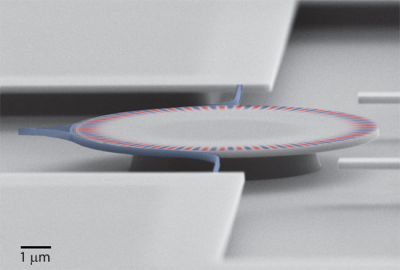Scientists from JQI and the Institute for Quantum Optics and Quantum Information (IQOQI) suggest that ring resonators can be used to develop micro-optical diodes.
 Image of an optical ring resonator, taken with a scanning electron microscope. (Image courtesy of K. Srinivasan, NIST)
Image of an optical ring resonator, taken with a scanning electron microscope. (Image courtesy of K. Srinivasan, NIST)
The silicon-on-insulator technology forms the basis in addition to facilitating compliance with the CMOS fabrication processes. Optical technology, demonstrated by other researchers, will also support this approach. Faraday rotation will allow one-way travel for photons, giving rise to polarization of light waves.
Researchers formulated an opto-mechanical diode, wherein an optical pathway called a waveguide is linked to an opto-mechanical resonator resembling a pedestal in appearance.
The waveguide functions as the optical analog while the mechanical resonator is the tool for creating diode-behavior in the waveguide. Ring-shaped resonators enable light to circulate within and undergo floppiness. The micro ring is capable of vibrating in varied ways. The scientists can make the resonator breathe radially by using the light present within the cavity.
Light emanating from both directions can travel along the waveguide, and will be absorbed or transmitted by the ring resonator depending on its wavelength.
Light, with the right frequency to enter the resonator and stimulate its breathing motion, will have a wave-like vibrational motion that interferes with the light wave within the resonator. The passage of light, even if it travelled either way, is still reciprocal. This is not an optical diode and light from either direction will be mildly affected by the vibrations, when not modified.
In order to make the photons to travel in one direction, an intense light called a ‘pump’ can be injected into one of the resonator pathways. With the pump, the influence of clockwise-moving light on the breathing is improved. The light can now be modulated. According to the outcome, the clockwise light will transmit iva the waveguide at certain wavelengths. The counterclockwise light lacking vibrations gets blocked or absorbed by the resonator. This is an optical diode.
Unlike macroscopic faraday rotator, this system can be switched on and off with the help of an optical beam.
However, based on the vibration of the light, the clockwise moving light will attain a different phase shift compared to the counterclockwise moving light. This optical isolator can function with single photons, in the quantum limit.
An array of these micro-resonator diodes can also enable the activation of quantum many-body systems.